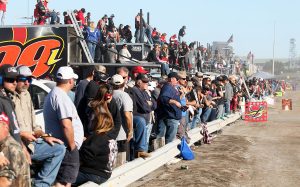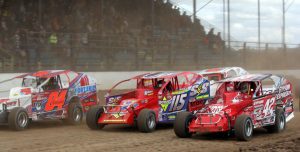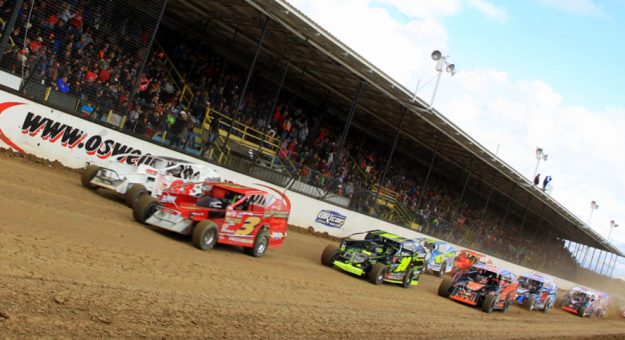Long billed as “racing’s biggest party,” Super DIRT Week has a half-century heritage at two of the nation’s best-known venues, the now defunct Syracuse Mile and, since 2016, the much smaller dirt-covered Oswego (N.Y.) Speedway.
A week of partying for hordes of campers may be the hook but racing, headlined by big-block modifieds, has been the foundation of a tradition that began when visionary promoter Glenn Donnelly took over the Syracuse franchise from Ira Vail in 1972.
Besides promoting the traditional Labor Day State Fair race, Donnelly used a 100-lapper in October, modeled on the National Open/Race of Champions at Langhorne (Pa.) Speedway, to build his DIRT empire.
DIRT brought uniform rules, TV coverage and Syracuse qualifiers featuring big-name drivers to the region’s short tracks. Initially known as the Schaefer 100, the Syracuse classic became the season’s richest with a win cementing legendary status in the sport.
Brett Hearn won six times on the mile, Stewart Friesen notched five wins between Syracuse and Oswego and Gary Balough and Billy Decker recorded four each. Alan Johnson won three times at Syracuse, including once from dead last, with two-time winners including Buzzie Reutimann, Jack Johnson, Merv Treichler, Jimmy Horton, Danny Johnson, Vic Coffey, Matt Sheppard and Mat Williamson, victorious the last two years at Oswego.
Add single winners Billy Osmun, Dick Tobias, Bob McCreadie, Kenny Brightbill, Richie Tobias, Doug Hoffman, Kenny Tremont Jr., Tim Fuller, Frank Cozze, Billy Dunn and Larry Wight for a Hall of Fame roster.
Some could have more wins. Tremont, for example, had a second triumph in hand in 2002 when he ran dry on the last lap. The entire top five dropped out in the last 10 laps, putting Coffey in victory lane.
Everyone who played the mileage game suffered whenever the race went over the advertised distance due to late-race caution laps that didn’t count or when track-blocking wrecks saw the field red flagged, then run a number of laps before the lap counter restarted.
“I also ran dry in ’98 while running second to Decker,” recalled Tremont. “It’s such a sinking feeling to be that close and run out. It’s always a gamble in a race where track position is everything. We all tried to park ourselves in front of the others on the last pit stop and ride it out.”

Friesen was affected differently, losing half of his $50,000 winner’s purse in 2011 for a “technical violation in the car’s fueling system.” Fuel-system tricks were a Syracuse tradition for many years.
By far, the most impressive feat was Cozze’s economy run in 2008, when he short-pitted on lap 71, inherited the lead on lap 124 and won without passing a car after his stop.
“It was dumb luck,” recalled Cozze. “We tried something different when we built that motor, concentrating on mileage instead of horsepower because I figured I could pass guys in the pits I couldn’t get around on the track. Then, the cautions came just when I needed them. The next year we went even further on a tank but had other problems.
“I was 20 the first time I went, back when they got 140 cars, and I didn’t qualify. I was 53 when I finally won and had a second and a third in between but nothing really matters if you don’t win.”
Another unforgettable highlight came in 1980, when Kenny Weld brought a high-roofed, super-wide “Lincoln” for Balough, already a big winner in the Ferraiuolo Bros.’ Grant King-built Gremlin. With a wing in the roof, ram air intake and ground-effects skirting, the car made the Gremlins of the day obsolete.
With Balough faster by seconds, teams cobbled together wider bodies with plywood interior wings but to no avail. Balough lapped the field with ease.
“I could drive most tracks straight, but especially Syracuse, which led to winning with the Grant King car,” Balough recalled. “But my legacy is the Batmobile. With that design I changed DIRT modified racing. They changed the rules to counter us but by the next year, the cars were all entirely different.”
One factor beyond control was Syracuse’s weather, often featuring sun, high wind, cold, rain and even snow in the span of a few hours.
Donnelly’s track crew was famous for their grader’s rubber “squeegee” blade that removed standing water. And it was not uncommon for announcer Joe Marotta to ask spectators to put their cars and trucks out on the track to run it in.
Fans who endured multiple rainouts in October 1977 returned in April amid constant snow flurries, though what most remember is the horrific backstretch wreck where Tighe Scott’s flying car sheared Wayne Reutimann’s roll cage completely off and fire spread throughout the scene.
Other scary incidents came during the 1978 Super Nationals, for years the Saturday attraction. Randy Wolfe and Van May both took heart-stopping fliers and landed with their sprint cars torn completely apart.
Eventually, officials decided the track was too fast for sprint cars and late models. How fast was it? In 1994, modified superstar Billy Pauch highlighted one of his excursions into sprint car racing with a world-record time trial lap of just over 144 mph with the Zemco No. 1 entry.
“It was a normal Syracuse,” recalled Pauch. “The fast way around was right on the rail. Officially, I led all the way but once a lapped car held me up and Jac Haudenschild and Dave Blaney got by. I got the lead right back, then on the last lap Blaney trapped me behind another lapped car into one, but he slipped up and I got back by. I was the only outsider to beat the Outlaws that year and I got offers to run Silver Crown, a late model in Arizona and a midget for the Chili Bowl. It made me a national presence. We not only won, we dominated and it opened a lot of doors.”
Blaney also raced the big blocks, saying they “felt slow” after the sprinters. He passed cars at will around the outside and could have won three races. Instead, he suffered a suspension failure, a crash and, in 1994, lost to teammate Jimmy Horton.
A driver with better luck was Pro Stock kingpin Rob Yetman, who loved Syracuse.
“I won the last three on the mile and in ’16 and ’17 at Oswego but there’s no comparison at all,” Yetman said. “The speed and atmosphere at Syracuse were badass. You can’t replace that. Two of the four years at Oswego the track has been garbage. When you’re snapping frames in half you’ve got big problems. The other two years it sealed over and was smooth as glass. Somebody has to figure out how to do that every year when they put the dirt down.”

Besides the Pro Stocks, 358 small blocks, sportsmen and USAC’s Silver Crown cars also graced the mile. Current modified stars Sheppard and Eric Rudolph made their bones by winning the sportsman race. Big 358 winners included Decker (7), Hearn (6), Pete Bicknell (5) and Tremont (4).
While many fans thought the “modern era” Silver Crown cars looked slow, they loved modified star Richie Tobias and USAC stalwart J.J. Yeley’s duel for the win in 2002.
Opinions vary as to whether Oswego will truly replace Syracuse. Australian Peter Britten said, “I think history and tradition are very important and that makes me sad about Syracuse going away.
“But from the aspect of where racing is now, Oswego makes more sense,” Britten added. “I’ve won the 358 race there and been second, third and wrecked in the 200. Super DIRT Week has never been about being the fastest, it’s about luck, pit strategy and yellows falling in your favor.”
“Syracuse had its pitfalls but to me, it will always be Super DIRT Week,” added Decker. “Oswego is a big event but it still feels different. I was lucky enough to win a few at Syracuse and being out there on the big concrete slab in front of that huge grandstand was awesome. There was a lot of pressure even if you won, knowing Foyt, Andretti and all the other greats had raced there.
“Syracuse was our holy grail. We won by having a fast car, not on gas mileage. Now you go with a Saturday night car, which is good, but there’s no tradition yet.”
Friesen, who saw his first Syracuse race at age 7 (Hearn won) agreed.
“I still miss Syracuse. I miss the speed and the uniqueness of the event,” he said. “There, we were racing on the big stage. They’ve recreated the party atmosphere at Oswego but otherwise, it’s just not the same, though it might be if they could get some consistency with the track surface from year to year and run the big blocks at night like we do the small blocks. Big blocks on a daytime track are a mess.”
Sheppard makes the point that “there have been really good and really bad races either place. When Oswego is smooth, the racing is great. We came from last to pass Britten on the last lap for the win after changing tires in one of the best DIRT week races ever.
“It’s a really big event paying big money, but it hasn’t evolved like some other signature events. We don’t need radios, to buy parking or be there for a week. It costs a lot more to race there for 50 grand than other places I race for 50 or more. It should be a shorter race on Saturday night under the lights for more money, like Knoxville or Eldora. They don’t run the Knoxville Nationals on Sunday afternoon with pit stops.”
Another 50 years from now, the racing world will know how it all shakes out.
